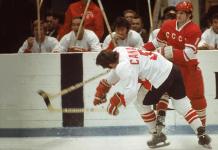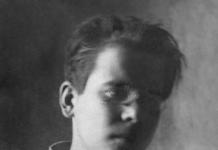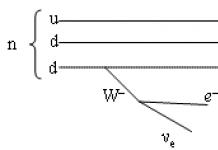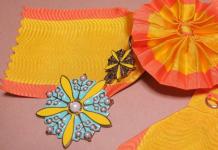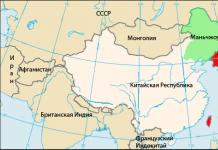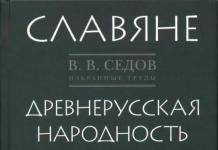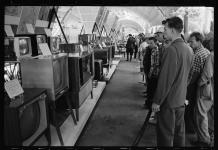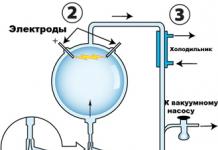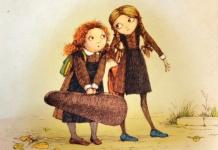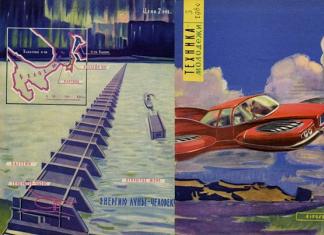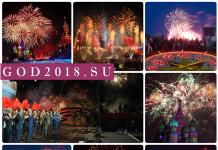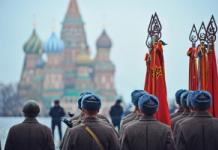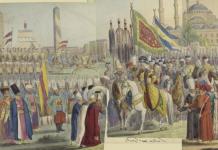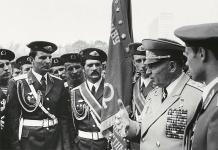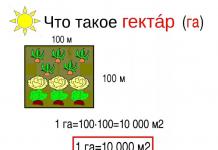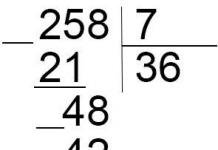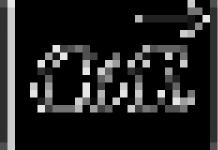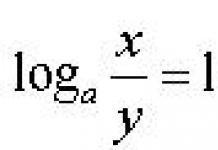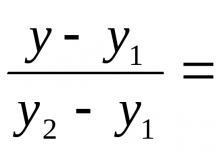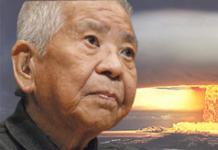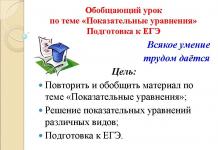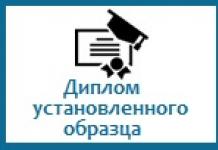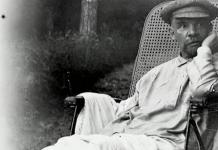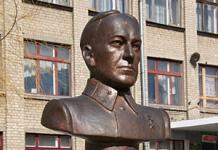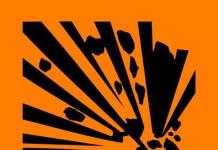Peter Karlovich Klodt (Klodt von Jurgensburg) (it. Peter Clodt von Jürgensburg; 1805-1867) is an outstanding Russian sculptor.
Boy, boy, officer
The family of the future sculptor consisted of hereditary military men. As is often the case, the surname was not rich, albeit well-born. His great-great-grandfather was one of the famous figures of the Northern War, was a major general in the Swedish service. The sculptor's father was a military general, fought in the Patriotic War of 1812. The portrait of the illustrious general occupies a worthy place in the gallery of the Winter Palace.Despite the fact that P.K. Klodt was born in 1805 in St. Petersburg, he spent his childhood and youth in Omsk, where his father served as chief of staff of the Separate Siberian Corps. There, far from the standards of metropolitan education, far from European culture, the baron's penchant for carving, modeling and drawing was manifested. Most of all, the boy liked to portray horses, he saw a special charm in them. Like his ancestors, the boy was preparing for a military career. In 1822, at the age of 17, he returned to the capital and entered the artillery school. All the free time that remained from learning the military craft, he gave to his hobby. It is also known that during this period Klodt devoted a lot of time to studying the postures, gaits and habits of horses. "Comprehending the horse as a subject of artistic creation, he had no other mentor than nature." After graduation, the future sculptor received the rank of second lieutenant. The officer served in the training artillery brigade until the age of 23, and after that, in 1828, he left military service and decided to continue to engage exclusively in sculpture.
Sculptor
For two years Klodt studied independently, copied modern and antique works of art and worked from nature. Since 1830 he has been a volunteer at the Academy of Arts, his teachers were the rector of the Academy I.P. Martos, as well as masters of sculpture S.I.Galberg and B.I. Orlovsky. They, approving the work and talent of the young sculptor, helped him achieve success. Klodt's talent and tenacity brought unexpected dividends: from the beginning of the 1830s, his statuettes depicting horses began to enjoy great success.
Horses of the Narva Gate
A strong continuation of his career was a large government order for the sculptural decoration of the Narva Gate, together with such experienced sculptors as S. S. Pimenov and V. I. Demut-Malinovsky. Six horses are installed on the attic of the arch, carrying the chariot of the goddess of glory, made of forged copper according to Klodt's model in 1833. In contrast to the classical depictions of this plot, the horses performed by Klodt rapidly rush forward and even rears up. At the same time, the entire sculptural composition gives the impression of a rapid movement. After completing this work, the author received worldwide fame and patronage of Nicholas I. There is a legend that Nicholas I said: "Well, Klodt, you make horses better than a stallion."
Anichkov bridge
 Anichkov Bridge in the 1850s |
In late 1832 - early 1833, the sculptor received a new government order for the execution of two sculptural groups to decorate the palace pier on the Admiralty Embankment. In the summer of 1833, Klodt made models for the project, and in August of the same year, the models were approved by the emperor and delivered for discussion to the Academy of Arts. The members of the Academic Council expressed their complete satisfaction with the work of the sculptor and it was decided to complete both first groups in full size. After this success in work on this project, there was a break due to the fact that Klodt was completing work on the sculptural composition of the Narva Gate. This break ended in the mid-1830s and work on the project continued. Emperor Nicholas I, who oversaw the project of the pier, did not approve of the combination of lions and horses. Instead of the Dioscuri, vases were installed on the pier. P.K. Klodt drew attention to the project of rebuilding the Anichkov Bridge and proposed to put the sculptures not on the piers of the Admiralteiskaya embankment or on the Admiralteisky Boulevard, but to transfer them to the supports of the Anichkov Bridge. The proposal was approved and the new project provided for the installation of two pairs of sculptures on four pedestals on the west and east sides of the bridge. By 1838, the first group was realized in kind and ready to be translated into bronze. Suddenly an insurmountable obstacle arose: he suddenly died without leaving a successor, the head of the Foundry House of the Imperial Academy of Arts, V.P. Ekimov. Without this person, the casting of sculptures was impossible, and the sculptor decided to independently supervise the execution of the casting work.
Incarnation in bronze
To carry out the work, the skills of the foundations of foundry came in handy, which he was taught at the artillery school, practically mastered in the service in the artillery and used in the lessons of V.P. Ekimov when Klodt was a volunteer at the academy. After heading the Foundry yard in 1838, he began to improve, bringing technological innovations and modern methods to the work of production. The fact that the sculptor became a caster brought unexpected results: most of the cast statues did not require additional processing (chasing or corrections). To achieve this result, meticulous work on the wax original was required with reproduction of the smallest possibilities and the whole casting of the composition (up to this point, such large sculptures were cast in parts). Between 1838 and 1841, the sculptor managed to make two compositions in bronze and began preparations for casting a second pair of sculptures. On November 20, 1841, the bridge was opened after restoration. Two pairs of sculptural compositions stood on the side pedestals: bronze groups were located on the right bank of the Fontanka River (from the Admiralty side), and painted plaster copies were installed on the pedestal. Re-casts were made in 1842, but they did not reach the bridge, the emperor presented this pair to the Prussian king Frederick William IV and, at his direction, the sculptures went to Berlin to decorate the main gate of the imperial palace. In 1843-1844 copies were made again. From 1844 to the spring of 1846, they remained on the pedestals of the Anichkov Bridge, then Nicholas I sent them to the "King of both Sicilies" Victor Emmanuel II (to the Royal Palace in Naples). Also, copies of sculptures are installed in gardens and palace buildings in Russia: in the vicinity of St. Petersburg - at the Oryol Palace in Strelna and Peterhof, as well as on the territory of the Golitsyn estate in Kuzminki near Moscow, the Kuzminki-Vlakhernskoye estate. Since 1846, plaster copies were again placed on the eastern side of the Anichkov Bridge, and the artist began to create a further continuation and completion of the ensemble. The participants in the composition were the same: the horse and the driver, but they had different movements and composition, as well as a new plot. It took the artist four years to make the copies, and in 1850 the plaster sculptures finally disappeared from the Anichkov Bridge, and in their place the soldiers of the Sapper Battalion under the leadership of Baron Klodt hoisted new bronze figures in place. The decoration of the Anichkov Bridge was completed.
Plot
- In the first groupthe animal is obedient to man - a naked athlete, squeezing the bridle, restrains the reared horse. Both the animal and the person are tense, the struggle is growing.
- This is shown using two main diagonals: the smooth silhouette of the horse's neck and back, which can be seen against the sky, forms the first diagonal that intersects with the diagonal formed by the figure of the athlete. The movements are highlighted with rhythmic repetitions.
- In the second group
the head of the animal is turned up high, the mouth is bared, the nostrils are swollen, the horse beats with its front hooves in the air, the figure of the driver is deployed in the form of a spiral, he is trying to upset the horse.
- The main diagonals of the composition approach each other, the silhouettes of the horse and the driver seem to intertwine with each other.
- In the third group
the horse overcomes the driver: the man is thrown to the ground, and the horse tries to break free, triumphantly arching its neck and throwing the blanket to the ground. The freedom of the horse is impeded only by the bridle in the driver's left hand.
- The main diagonals of the composition are clearly expressed and their intersection is highlighted. The silhouettes of the horse and the driver form an open composition, in contrast to the first two sculptures.
- In the fourth group
man tames an angry animal: leaning on one knee, he tames the wild run of the horse, squeezing the bridle with both hands.
- The silhouette of the horse forms a very flat diagonal, the silhouette of the driver is indistinguishable due to the drapery falling from the back of the horse. The silhouette of the monument again received isolation and poise.
Prototypes
 Statues of the Dioscuri in the Roman Forum. |
The figures of the Dioscuri in the Roman Forum on the Capitol Hill served as a direct prototype of Klodt's horses, but these antique sculptures had an unnatural motive of movement, and there was also a violation of proportions: in comparison with the enlarged figures of young men, the horses look too small. Another prototype was the "Horses of Marly" by the French sculptor Guillaume Couste (fr.), Created by him around 1740, and located in Paris at the entrance to the Champs Elysees from the Place de la Concorde. In the interpretation of the Kustu, the horses personify the animal principle, symbolize the impetuous indomitable ferocity and are depicted as giants next to small drivers. Klodt, in turn, depicted ordinary cavalry horses, whose anatomy he studied for many years. The realism of proportions and plastics was depicted by the sculptor in the traditions of classicism and this helped to inscribe the sculptural decoration of the bridge in the historical architectural landscape of this part of the city. One of the major differences between this composition and the works of its predecessors is the rejection of the idea of complete and unconditional symmetry and the creation of a sequential work, consisting of four compositions.
Outcomes
The sculptor spent 20 years of his life on this work. This work has become one of the most significant and famous works of the sculptor. After discussing the first two sculptural compositions at the artistic council in 1833, the academic council decided to elect the sculptor to the appointed academicians, which was done five years later - in 1838. Also in the same year, he was appointed professor of sculpture and headed the Foundry yard of the Imperial Academy of Arts. The work itself was recognized by contemporaries as one of the pinnacles of fine art, comparable to the painting by KP Bryullov "The Last Day of Pompeii". In a short time, she acquired European fame. Finally, the statues took their places only 10 years after the installation of the first options. They left their plinths twice:
- In 1941, during the blockade, the sculptures were removed and buried in the garden of the Anichkov Palace.
- In 2000, the sculptures were removed from the bridge for restoration.
Recognized master
After he was recognized as a master of his craft, Klodt performed other sculptural works, but, according to art critics, the horses on the Anichkov Bridge remained his best work.
Service house
In the 1845-1850s, Klodt took part in the reconstruction of the "Service House" of the Marble Palace: according to the project of A.P. Bryullov, the ground floor was intended for palace stables, and the building overlooking the garden was supposed to become an arena. In connection with this purpose, to decorate the building along the facade, above the windows of the second floor, along the entire length of the middle part of the building, a seven-meter relief "Horse in the service of man" was made. It was executed by Klodt according to the architect's graphic sketch; it consisted of four blocks, not united by a common plot or idea:
- Combat fights of riders;
- Horse processions;
- Horseback riding and chariot rides;
- Hunting plots.
Art critics believe that this relief was made by Klodt in the image and likeness of horses on the frieze of the Parthenon. This opinion is supported by the Roman clothing of the people depicted on the reliefs. The tympans of the lateral pediments were also made by Klodt and depicted newts blowing into shells.
Monument to Krylov
The entire long life of the great Russian poet, who worked in the genre of fables, was associated with St. Petersburg: he came here at the age of thirteen and lived here for over sixty years, practically never leaving St. Petersburg. In this city, fame and popular love came to Krylov. When he left this world in 1844, his death was perceived as a nationwide grief. A year later, in 1845, an all-Russian voluntary subscription was announced through the newspapers in order to erect a monument to the fabulist. In 1848, more than 30 thousand rubles were collected, and a competition was announced by the Academy of Arts, in which all the leading sculptors of that time took part. The competition was won by Klodt's project. The original sketch was executed in the monumental traditions of antiquity: The Mighty Poet in a Roman toga with a bare chest. But on the same sheet there is a version of the monument, reminiscent of the one in the Summer Garden. Klodt was able to use an innovative technique: he created a monument, unlike the plastic images of commanders, kings, nobles, who in his time adorned St. Petersburg and Moscow, abandoning the familiar language of allegories and creating a realistic portrait image. The sculptor depicted the fabulist sitting on a bench dressed in casual clothes in a natural relaxed posture, as if he had sat down to rest under the linden trees of the Summer Garden. All these elements focus on the poet's face, in which the sculptor tried to convey the characteristics of Krylov's personality. The sculptor managed to convey the portrait and general resemblance of the poet, which was recognized by his contemporaries. The artist's idea went beyond a simple image of the poet, Klodt decided to create a sculptural composition, placing high-relief images of the characters of fables along the perimeter of the pedestal. The images are illustrative, and in 1849, to create the composition, Klodt recruited the famous illustrator A.A.Agin to work. Klodt transferred the figures to the pedestal, carefully checking the images with living nature. The work on the monument was completed in 1855.
Monument criticism
Klodt was criticized for petty pickiness in order to achieve maximum realism in the depiction of animals in high relief, pointing out to the author that the characters in the fables in the imagination of readers were more allegorical than they were real crayfish, dogs, foxes. In addition, the authors of the monument were criticized for the disparity between the high relief of the pedestal, which is complex in composition, and the realistic artistic solution of the portrait statue. Despite this criticism, the descendants highly appreciated the work of the sculptors, and the Krylov monument took its rightful place in the history of Russian sculpture.
Monument to Prince Vladimir of Kiev
In 1833-1834, the sculptor V.I.Demut-Malinovsky worked on the project of a monument to Prince Vladimir of Kiev - the Kiev prince from 978 (according to other sources - from 980), the initiator of the baptism of Rus in 988. The work ended with the presentation in 1835 of the project to the President of the Imperial academy of arts. For unclear reasons, work on the project was suspended for a decade. In 1846 Demut-Malinovsky died, after which the architect K.A.Ton took over the management of the work. At the end of the same year, information appears that "The project is accepted for execution"... Tone rearranged the project, taking as a basis the sketch of Demut-Malinovsky's model and designed the pedestal in the form of a high tower-like church in the pseudo-Byzantine style. At that time, Klodt was in charge of the foundry yard of the Academy of Arts, he was entrusted with casting the monument in bronze. Before casting, he had to reproduce a small figurine made at one time by Demut-Malinovsky on a gigantic scale of a monument. While doing this work, it is inevitable to make changes relative to the model. It is impossible to assess these differences, since it is not possible to compare the draft design with the monument: the draft model has not survived. Klodt did a great job on the face of the sculpture, giving it an expression of spirituality and inspiration. The monument is a bronze statue 4.5 meters high, installed on a pedestal 16 meters high. The monument is laconic and austere, in style it belongs to the typical examples of Russian classicism. Prince Vladimir is dressed in a long, flowing cloak, in his hand is a cross, which he extends over the city. Klodt did his job very conscientiously, moved the statue from St. Petersburg to Kiev, and very well chose a place for it: the statue is inscribed in the high mountainous landscape of the Dnieper bank. The monument was erected in Kiev on the banks of the Dnieper in 1853. The monument was replicated on money - its image was used as a decoration for a banknote of Ukraine in denomination of 100 thousand karbovanets.
Monument to Nicholas I
Nicholas I (1796-1855) - All-Russian Emperor (1825-1855).
The monument to be installed on St. Isaac's Square in St. Petersburg was designed by Auguste Montferrand in 1856-1859. The monument was designed as a unifying center of a diverse architectural ensemble of a large area between the Mariinsky Palace and St. Isaac's Cathedral. Several sculptors worked on the design of the monument: Klodt himself made the figure of the emperor. The pedestal was designed by sculptors:
- N. A. Romazanov created three bas-reliefs.
- RK Zaleman in 1856-1858 completed four allegorical female figures: "Strength", "Wisdom", "Justice" and "Faith", and a bas-relief on the same pedestal depicting Count MM Speransky Code of laws to the emperor.
- The top of the composition is the equestrian figure of the emperor. The original sketch, created by Klodt, was of a rider on a calmly standing horse. The author planned to use facial expressions and gestures to reflect the character of the emperor, but this option was rejected by Montferrand because it could not serve the original purpose of uniting spatial ensembles. The sculptor created a new sketch. In it, abandoning the idea of characterizing the character, he depicted a horse in motion, resting only on the hind pair of legs. In this impetuous pose of a horse, the ceremonial figure of the emperor stands in opposition to it. To implement this sketch, the sculptor took the trouble to accurately calculate the weight of the entire equestrian figure in order for it to stand, relying only on two points of support. This version was accepted by the architect and embodied in bronze. Usually, everyone who turned to the description of the statue of Nicholas I noted the technical skill of performing the most difficult task - setting the horse on two points of support. For their strength, Klodt ordered iron supports (weighing 60 poods, worth 2000 rubles in silver) from the best plant in Olonetska.
Assessment of work in Soviet times
- Soviet historians and art historians did not highly appreciate the compositional and stylistic composition of the monument and noted that the elements did not look like a single composition:
- The pedestal, the reliefs on the pedestal and the equestrian statue are not subordinate to a single idea and to some extent contradict each other.
- The forms of the monument themselves are crushed and overloaded with small details, and the composition is pretentious and overly decorative.
- At the same time, the positive features of the composition can be distinguished:
- The composition meets the intended purpose and, complementing the ensemble of the square, gives it completeness and integrity.
- All parts of the whole are professionally made by masters of their craft, the artistic value of the elements is undeniable.
- Despite the fact that everything connected with tsarism was eradicated after the 1917 Revolution, the monument to Nicholas I on St. Isaac's Square due to its unique feature - a heavy equestrian statue rests only on its hind legs - was recognized as a masterpiece of engineering thought and was not destroyed in Soviet times.
Together with sculptors A.V. Loganovsky, N.A. Romazanov and others, worked on sculptures of the memorial temple in the "Russian-Byzantine" style - the Cathedral of Christ the Savior (built for almost 40 years), since September 10, 1839.
The summary of the life of the sculptor
In addition to the tangible legacy in the form of graphics and plastics, which the master left to descendants, he conquered several more peaks in his life:
- Heading the Foundry Yard of the Academy of Arts, he achieved an improvement in the quality of artistic casting in Russia, and this gave impetus to the development of this art in Russia.
- He brought Russian animal studies to a new level, making it a self-sufficient discipline of art.
Small sculptural forms
Throughout his career, Klodt has worked in the direction of small forms plastics. The statuettes of this author were highly valued by his contemporaries. Some of them are recognized as works of art and are included in the collections of museums such as the State Russian Museum.
Death
The artist spent the last years of his life at his dacha (Halala manor, Grand Duchy of Finland), where he died on November 8 (20), 1867. He was buried at the Smolensk Lutheran cemetery, in 1936 the ashes were transferred to the Necropolis of Artists.
Pyotr Klodt comes from a poor, but very aristocratic German family, consisting of valiant warriors. His great-grandfather was one of the brightest people in the history of the Northern War, who honestly served Sweden with the rank of Major General. Peter's father was a general who showed himself on the battlefields in the Patriotic War of 1812. The young years of the future sculptor were spent in Omsk, where his father served. It was here, in a quiet city, far from the noisy and brilliant Petersburg with its temptations and vices, that Klodt became interested in drawing and modeling, reviving in his works the images of horses, which he obtained especially picturesquely and realistically.
After studying at the Cossack military school, Klodt returned to St. Petersburg. At that moment he was 17 years old. He entered the artillery school without any problems, but he devoted his free hours with inspiration to his favorite hobby. At the slightest opportunity, Baron Klodt took up a pencil or penknife and drew or carved out the figures of horses, while simultaneously studying in depth the habits of graceful animals.
After graduating from college, Klodt received the full rank of second lieutenant and even served for some time in the training artillery brigade, but already in 1828 he left military service, deciding from now on to engage only in sculpture. Two years later, without stopping to engage in self-education, he entered the Academy of Arts as an auditor. It was in the workshop of the famous foundry worker Yekimov, who supervised the casting of the most significant monuments of the early 19th century. It was Yekimov who initiated the student into the secrets of his craft.
Klodt was also patronized by the rector of the Academy - Martos Ivan Petrovich, who encouraged the beginnings of a young sculptor who lived in one of the basements of the Academy and, as the rumor has it, often kept horses here, from which he sculpted statuettes that brought him a good income. It should be noted the foresight and simplicity of Martos, who often invited Klodt to visit and easily agreed to marry one of his daughters, Juliania Ivanovna, who became Klodt's devoted wife.
Sokolov Petr Fedorovich. "Portrait of P.K. Klodt" Photo: Commons.wikimedia.org
Narva Triumphal Gates and the first fruits of glory
The diligence and undoubted talent of Peter Klodt quickly brought their results. In 1831, together with the sculptors Pimenov and Demut-Malinovsky, he received a serious government order and began work on the creation of an elegant sculptural group of six horses harnessed to the chariot of Glory (now it adorns the arch of the Narva Triumphal Gate). Klodt's horses are animals rushing and heaving upward. They feel wild indomitability and crushing energy, which gives the arch not only a solemn, but also a truly triumphant look.
The ingenious work received its recognition. The young master was awarded the title of academician, as well as an apartment at the Academy of Arts and a large workshop where Klodt spent most of his time. Often he aroused gossip and gossip in refined St. Petersburg society, in which he appeared as an obsessed artist in an ever-soiled blouse, with a disheveled head, meeting in a dirty workshop the best representatives of the nobility and even members of the dynasty, not particularly ceremoniously and behaving extremely simply.

How Nicholas I gave horses
The next monumental work, which brought Klodt to Olympus fame, was an order for the execution of two sculptural groups "Horse Tamers", with which they first wanted to decorate the docks of Admiralteysky Boulevard (now the Alexander Garden is located in this place - approx.). The order was received in 1832. Work continued until 1841, when two bronze sculptural groups appeared on the western abutments on the Anichkov Bridge, and their plaster copies made in bronze on the eastern abutments. However, the horses did not stand on the bridge for long: already in 1842 Nicholas I sent them as a gift to the Prussian king Frederick William IV, in 1846 the newly cast horses were presented to the King of Sicily Ferdinand II, and even later copies of The Horse Tamers were installed in Peterhof, Strelna and at the Horse Yard of the Kuzminki estate near Moscow.
Klodt, who by that time probably should have felt sick from this line of horses, decided not to make copies anymore. In 1850, bronze statues were installed on the Anichkov Bridge, which were cast according to new models, as a result of which a composition of four different sculptural groups appeared, representing a dramatic story with a consistently developing plot: the conquest of a horse by a man who triumphs in the struggle over the merciless power of nature.
If you look closely at the sculptures, you can see that in the first group the naked athlete with an effort restrains the horse, in the next - he pulls him down with a mighty movement, in the third - the fight reaches its peak - the person is thrown to the ground, and in the last composition the athlete, falling on one knee, grabs the horse, and, holding the line with both hands, nevertheless gains the upper hand over the animals. There is one more interesting detail for observers: the statues of horses "looking" towards the Admiralty are shod, but the statues of those looking towards Vosstaniya Square are not. This is explained by the fact that foundries and forges were located on Liteiny Prospect, and therefore shod horses "go" from the forges, and bare horses, on the contrary, follow in them.


For his masterpiece, Pyotr Klodt received a professorship and a significant annual pension. It would seem that now he could not worry about a comfortable future, but the sculptor was tireless. His next significant work was the monument to the fabulist Ivan Krylov in the Summer Garden. The publisher of satirical and educational magazines sits on a pedestal decorated with images of animals from famous fables. The last work of Klodt was the equestrian monument to Emperor Nicholas I, which stands on St. Isaac's Square. The sculpture is remarkable not only from an artistic, but also from a technical point of view: the statue has only two points of support without any auxiliary support, which cannot but attract attention and cause an exclamation of admiration.
The original sketch, created by Klodt, was of a rider on a calmly standing horse. Photo: Commons.wikimedia.org
The last masterpiece
Piotr Klodt died in 1867 at the age of 62, having spent the last years of his life on the Halala manor in Finland. Death overtook the sculptor at the moment when he began to cut out a cardboard horse - his last, unfinished creation, a small masterpiece for his beloved granddaughter.

Pyotr Klodt was born in 1805 in St. Petersburg into a military family, descended from an old German family. His father was a general, a hero of the Patriotic War of 1812. Despite the fact that the future sculptor was born in the capital, he spent his youth in Omsk, far from European education and culture. Like his ancestors, he wanted to connect his life with a military career - in Omsk he was a cadet in a Cossack school, and upon returning to St. Petersburg he entered an artillery school. Despite this choice, during the years of his studies, at every opportunity he took up a pencil or a penknife - he cut out figures of horses and people - a hobby that his father "infected" him.
After completing his studies, Klodt was promoted to ensign, served in an artillery brigade, but in 1828 he left the service to focus exclusively on art. For two years he studied on his own, after which he became a volunteer at the Academy of Arts: the rector of the academy Martos and teachers, seeing talent and skill in Klodt, helped him achieve success. Over time, he became a real master of his craft and was known not only at the imperial court, but also far beyond its borders. The most famous creation of Klodt is, of course, sculptures horse tamers on the Anichkov bridge in St. Petersburg, but his other works are no less magnificent. "Evening Moscow" invites you to remember the most famous of them.
Horses of the Narva Triumphal Gate
Klodt carried out this large government order together with such experienced sculptors as S. Pimenov and V. Demut-Malinovsky. On the attic of the arch there is a six horses carrying a chariot of the goddess of glory, made of forged copper according to Klodt's model in 1833. In contrast to the classical depictions of this plot, the horses performed by Klodt rapidly rush forward and even rears up. At the same time, the entire sculptural composition gives the impression of a rapid movement. After completing this work, the author received worldwide fame and patronage of Nicholas I. There is a legend that Nicholas I said: "Well, Klodt, you make horses better than a stallion."
The most famous creation of Klodt is, of course, the sculptural group of horse tamers on the Anichkov bridge in St. Petersburg, but other works of the master are no less magnificent.
"Horse Tamers" of Anichkov Bridge
The famous "Horse Tamers" were originally supposed to be located not at all where they can be seen today. The sculptures were supposed to decorate the docks of Admiralteisky Boulevard, at the entrance to Palace Square. It is noteworthy that both the place and the project itself were approved by Nicholas I... When everything was already ready for casting, Klodt decided that it was useless to tame horses near water and ships. He began to look for a place and rather quickly his choice fell on the Anichkov Bridge, which was already in need of reconstruction and was rather plain. The sculptor hinted at his idea, and the emperor supported him. Nikolai provided the sculptor with two purebred Arabian stallions - he was allowed to do whatever he liked with them. Klodt's experience gained while studying at the Academy was very useful - at that time he was a student of one of the outstanding Russian foundry workers Yekimov, and by the time the "Tamers" was created he had already managed to head the entire Foundry Dvor. Seeing the first bronze blanks, the emperor told the sculptor that they came out even better than the stallions actually looked.
On November 20, 1841, the grand opening of the Anichkov Bridge after reconstruction took place, to which the Petersburgers literally walked in droves. But then the residents did not see the true beauty of Klodt's work - Nicholas I decided to donate two sculptures to the Prussian king Friedrich Wilhelm, and painted plaster copies were installed instead. Three years later, the copies were re-made, but they did not last long either - this time the "king of the two Sicilies" Ferdinand II became their lucky owner. Only in 1850 did the plaster copies finally disappear from the bridge, and bronze figures took their place.

Anichkov Bridge in the 1850s
Monument to Ivan Krylov
The life of the famous fabulist is almost inextricably linked with St. Petersburg - he lived in the city for almost sixty years, rarely leaving its borders. His death in 1844 became a national tragedy, and a year later a voluntary subscription was announced, the purpose of which was to raise money for a monument to the famous poet. In 1849, Klodt's project won an open competition. The initial sketches assumed the creation of an almost antique image of the poet, but the sculptor took a bold step - he abandoned the ideas of the embodiment of idealistic images prevailing at that time, and wanted to depict the poet as accurately as possible, in a natural setting. According to contemporaries, he managed to achieve almost portrait resemblance to the original. Along the perimeter of the pedestal, the sculptor placed animals - the heroes of Krylov's fables. The monument adorns the Summer Garden of St. Petersburg to this day.

Monument to Nicholas I on St. Isaac's Square
Monument to Prince Vladimir of Kiev
In 1833 the sculptor V. Demut-Malinovsky worked on the project of a monument to Prince Vladimir of Kiev - the initiator of the baptism of Rus in 988. The work ended with the presentation in 1835 of the project to the President of the Imperial Academy of Arts. For unclear reasons, work on the project was suspended for a decade. In 1846, Demut-Malinovsky died, after which the architect K. Ton took over the management of the work, who designed the pedestal in the form of a high tower-like church in the pseudo-Byzantine style. At that time, Klodt was in charge of the foundry yard of the Academy of Arts and he was entrusted with casting the monument in bronze. Before casting, he had to reproduce a small figurine made at one time by Demut-Malinovsky on a gigantic scale of a monument. While doing this work, it is inevitable to make changes relative to the model. It is impossible to assess these differences, since it is not possible to compare the draft design with the monument: the draft model has not survived. Klodt did a great job on the face of the sculpture, giving it an expression of spirituality and inspiration. The sculptor did his work very conscientiously, transported the statue from St. Petersburg to Kiev, and very well chose a place for it: it is inscribed in the high mountainous landscape of the Dnieper bank.

Monument to Prince Vladimir of Kiev
Monument to Nicholas I
The monument to the controversial but outstanding emperor was laid a year after his death - in 1856. It was initially a complex project, on which several sculptors had to work, but the most responsible work - the embodiment of the sovereign's figure - was entrusted to Klodt. He managed to successfully cope with the task only the second time - during the first attempt, the shape of the sculpture could not stand, and the molten bronze flowed out. Nicholas' heir, Alexander II, allowed the sculptor to make a second casting, which proved to be successful. In order to take the sculpture out of the Imperial Academy of Arts, where it was cast, it was necessary to break the walls: its dimensions were so great. On June 25, 1859, the monument was inaugurated in the presence of Alexander II... Contemporaries were amazed at an unprecedented achievement: Klodt managed to achieve that the sculpture of the rider was based on only two points of support, on the hind legs of the horse! In Europe, such a monument was erected for the first time, the only earlier example of such an embodiment of an engineering miracle was the American monument to President Andrew Jackson in the capital of the United States. After the October 1917 coup, the question of dismantling the monument as a legacy of the tsarist regime was repeatedly raised, but Klodt's artistic genius saved the monument from destruction: thanks to the uniqueness of the system of only two pillars, it was recognized as a miracle of engineering thought and preserved.

I am looking at a drawing from 160 years ago, where a certain artist reflected the 30-year-old sculptor Pyotr Karlovich Klodt: what a resemblance to his great-great-great-grandson Eugene, an artist-designer and my friend!
Evgeny Klodt: Our family has been known since the X-XII centuries. My father looked for the roots of the Klodts throughout Europe, for they left their mark everywhere. He found his ancestors in the genealogies of the ancient Lombard Caesars, veterans of Julius Caesar, in Westphalia, Saxony and Prussia, in the principalities of Ailen, Warburg, Braunschweig, in Livonia and Courland ...
But the fate of this lively and fruitful family suddenly took an amazing turn: from the 18th century the Klodts were resolutely "registered" in Russia. And then, in the full sense of the word, they shone.
The first Russian Klodt was named from birth Karl Gustav. At the courts and armies of their Imperial Majesties Catherine II, Paul I and Alexander I he was christened Karl Fedorovich. For impeccable service they were awarded the Orders of St. Vladimir and St. Anna. Golden sword - "For courage". With this sword Colonel Karl Klodt marched against the French in the Battle of Borodino. He finished his service as a baron and general, leaving Russia with five sons.
One of them was named Pyotr Klodt. His bronze horses have been decorating Anichkov Bridge for a century and a half. On the four of his winged horses, the god Apollo rides along the pediment of the Bolshoi Theater. From the walls of the Grand Kremlin Palace, George the Victorious rushes towards the insidious Serpent ...
Traitor to the clan
His "horse" fate was, as it were, predetermined: as a child, his father Karl sent his son Petka from the army of paper horses cut from playing cards; in his youth, as a cadet-artilleryman, he admired the dressage of the capital's hussars. But he did not go to the hussars. He liked not to prancing, but to watch horses - to become them, natural grace, innate nobility. In the artillery class, instead of ballistic trajectories, he drew horses. And once he saw how Peter cut a horse out of a birch log, his elder brother Vladimir exclaimed: "Petka, you are a traitor of our kind! Horseman! Coachman!"
But the "horseman" continued to make horses. Once on Peter's day, colleagues came to Warrant Officer Pyotr Klodt. An unfamiliar staff captain is with them. He looked at the wooden horses with interest. And suddenly he said: "Sell the horse, Baron!" - "Not for sale", - answered Peter. "From what?" - "The officer's honor does not order. But I can give it."
At the Palace Square, the architect Rossi erected the General Staff building - in memory of the war with Napoleon. And when the Chariot of Victory rose above the arch, sparkling, something exploded in Lieutenant Klodt's chest. Six bronze horses flew towards him from the skies. The next day he resigned ...
And then miracles began. Someone from the royal retinue presented Emperor Nicholas I with a wooden horseman. Adored such toys and, as you know, who loved to play "cavalry", the king said: "Charming. Who is this gifted carver?" - "Baron Klodt, Your Majesty. Retired lieutenant". - "Let a detachment of horse guards cut out for me." And, having received them, he ordered: "Now show me this baron!"
Miss Fortune
No joke: a retired lieutenant, a toy-maker, a poor man (even if the baron) has been invited to an audience with the emperor himself! As in a fairy tale, the Tsarev's test successfully passes: the self-taught, surprisingly to everyone, brilliantly copies German prints. Then he was highly recommended to the Academy of Arts, taken under its patronage. His life was suddenly put on a creative track: lectures at the Academy, copying antique marbles in museums and palaces, making new acquaintances ... But the sculpture is still "around the corner", and Pyotr Klodt still cuts his toys - horses and hussars that go snapped up.
Meanwhile, he is twenty-five - the age when true masters, as a rule, are already creating masterpieces. From Peter's toys to real sculpture, it seems, oh, how far is it! However, Lady Luck does not sleep. The mysterious fate of Klodt prepares for his astounding takeoff. New (stone, instead of wooden) Narva Triumphal Gates have already been erected, over which the Chariot of Glory is about to rise.
The chariot was fashioned by Demut, the figures of horses - by Pimenov. But the tsar suddenly declares that "Pimenov's horses are too thin." And he orders to call the equally famous sculptors Galberg and Orlovsky. However, both (out of professional solidarity or fear of displeasing the emperor) find a pretext for refusal. And then ... Then they suddenly remember the "toy" Klodt! Dazed, frightened, Peter hesitates. But they say to him: "You cannot refuse, Baron. For some people, perhaps it will do. But you will not be forgiven, for you are nobody."
And the incredible happens. The master, who had never worked in clay and plaster, in ancient classics and imperial forms, sculpted the first giant horse so that the commission was unanimous: "This model has been made with the desired success." All six horses were sculpted and cast in just a year. And the Chariot of Glory rushed off. The result was an even more impossible event: the self-taught sculptor was at once awarded the title of academician.
Yevgeny Klodt: In the same 1832, an event occurred in the life of Pyotr Karlovich, perhaps even more important: the young academician married the niece of Martos, the rector of the Academy, - Yulenka. And, as time has shown, he acquired a treasure worthy of all his future deeds. My great-great-grandfather, genre painter Mikhail Petrovich Klodt, recalled: "My mother was pretty, slender and graceful. Moreover, she had a cheerful character." "With Yulenka, I am like Christ in the bosom," Peter used to say. A kind of gift for the newlyweds was the next order of the tsar, who, years later, would lead Klodt to his Olympus - to the Anichkov Bridge.
The road to Anichkov
The Anichkov Bridge was still narrow and empty at that time. And, perhaps, he would have remained so if Nicholas I had not appointed the young sculptor a new meeting - this time in his horse-guards arena, at a show of English stallions.
The horses were taken out by the English vodnichy. The Tsar compared them with the mythological Dioscuri and asked Klodt: "What do you say, Baron?" “Noble horses, Your Majesty,” Peter answered evasively. “That's what,” the emperor continued. "We are rebuilding Palace Square: it would be nice to put horses and tamers there."
And Klodt thought that this time he could not do without a live horse, without genuine nature. The horse should be there all the time, day and night. This is the only way you can become a vodnik your horse: first you tame and tame it yourself, and only then saddle - a bronze one.
And so they brought two purebred Arab stallions from the tsar's stables to the academic stable - at the complete disposal of the sculptor: Peter could draw them, and sculpt, and feed them from his own hands, and harness them to his carriage.
And the work went on. Nicholas I, who visited the workshop and saw the horses still in the clay, said with admiration: "Baron, your horses are better than my stallions."
Evgeny Klodt: The first two groups were ready for casting. However ... How did Klodt's horses end up on the Anichkov Bridge? After all, both the tsar and then the academic council decided to install the "Tamers" (that was the conventional name) near the Admiralty Boulevard, at the entrance from the embankment to the Palace Square. But one fine summer evening, Pyotr Karlovich left the house and went to look for his place. Many years later, collecting material for a book about my great-great-grandfather, my father Georgy Klodt followed the same path.
"... Through the Isaac pontoon bridge," said his father, "Pyotr Klodt walked to the Admiralty and the Embankment, where he should put his horses. Right and left are the majestic spiers of Peter and Pauline and the Admiralty, between them the masts of ships. Well, if you look from the Nevsky "Right in the eye - a spire. So who and where will see his horses here? And, leaving the Admiralty behind him, he walked along Nevsky Prospect. He crossed the Moika River, looked at Teatralnaya. Returned to Nevsky. It seems that there was nowhere else. But he And he stopped on the Anichkov Bridge, and Nevsky was leaving as far as he could see: carriages were racing, officers were prancing, ladies and gentlemen were walking, officials were hurrying somewhere ... And, feeling a sudden heartbeat, Pyotr Karlovich understood - the choice was made: from this place he saw everything, and - everyone saw him! "
Cast it myself
Having decided (contrary to the Tsar's plan) to stage his sculptural "poem" on Anichkov, Peter only hinted about this to Nicholas - the agreement came by itself. The tsar understood that Anichkov was really out of date and needed reconstruction. And then Klodt's horses will be in place here.
The logic of Klodt's creative behavior invariably led him to success. So, while still a volunteer at the Academy, he became an apprentice to the best Russian foundry worker Vasily Yekimov. And having already become eminent, he did not leave artistic casting in order to reliably know what and how from sculpted will go into bronze. At that moment, when the first models were ready for casting, Yekimov suddenly died. And, as the only sculptor who perfectly mastered casting, Klodt was offered not only to dress his products in bronze, but also to head the entire Foundry House.
And now the solemn hour has come. A lot of people gathered around the smelting furnaces around Klodt and his henchmen. We were waiting for the start of the metal. The crowd, taking off their hats and crossing themselves, fell silent. The workers struck the cast with crowbars, and the molten bronze, breathing hotly and sparkling, flowed into the molds. Klodt was all in suspense. The workers were feverish from the heat - they were given milk to drink. The president of the Academy of Arts Olenin, unable to stand with excitement, sat outside the doors of the foundry and muttered prayers. Suddenly, a powerful "hurray" was heard. It is finished! Klodt went out to Olenin, collapsed next to him on a stool ...
And on the Nevsky Prospect, the Anichkov Bridge was being rebuilt. Architects, railroad workers, builders - all of St. Petersburg worked on Klodt horses. Soon the second group of "Tamers" was cast - the one where the young vodnichy holds the rearing horse. For both the first and the second bronze groups, Klodt made copies of them in plaster, tinted in bronze. The tsar was impatient to open the new Anichkov as soon as possible, placing sculptures on all four corners of the bridge. Did Pyotr Klodt then think that it would take another ten whole years before he played his entire brilliant performance in front of the Petersburgers at Anichkov - in four bronze scenes?
However, what St. Petersburg saw on November 20, 1841, amazed everyone: “The life of a horse and a man on Anichkov,” the newspapers wrote, “represents a new world in art. his hands and turned from the wrong road to the real one. "
The tsar summoned Klodt to him and said: he wants to glorify his creations all over the world. And for this he donates the already cast sculptures to the Prussian king Frederick William IV, who is crazy about them. Peter had to go to Berlin with a gift.
Yevgeny Klodt: Here, by the way, one of the most amazing features of Pyotr Karlovich became clear, which became a characteristic feature of our dynasty: a descendant of foreigners, he was so Russian in spirit, habits, predilections that, being in Germany, he terribly yearned for his homeland. However, Klodt's "suffering" was rewarded: Friedrich Wilhelm awarded him the Order of the Red Eagle and a diamond snuffbox.
In the same year, he cast The Tamers again. But already another guest of Nicholas I, the king of both Sicilies Ferdinand II, seeing the divine horses of Klodt, wished to see them every day in Naples. And having received them, he awarded Klodt with the Order of Naples. After that, European newspapers reported: "There are three miracles in Naples today: the body of the Savior taken from the Cross, covered with a transparent marble veil," The Descent of the Savior from the Cross "- a painting by Espagnoletta, and the bronze horses of the Russian Baron Klodt". Berlin, Paris, Rome awarded Peter Klodt with the title of honorary member of their Academies.
Instead of an epilogue
"Tamers" on Anichkovoye became Klodt's swan song, sung by the sculptor at the age of forty-five, in the prime of his creative powers. Composing his best creation, he at the same time takes part in decorating the interiors of St. Isaac's Cathedral - his gorelf "Christ in Glory" decorated the frieze over the Altar Gates. Creates a giant bas-relief for the Marble Palace, depicting hunting and road paintings on it. In 1849, a year before the complete completion of the epic on Anichkov, he won the competition for a monument to the Russian fabulist Ivan Andreevich Krylov. And already in 1852 he casts and seats his "grandfather" in the Summer Garden - with an open book in his hands, with a sadly pensive face, surrounded by a whole menagerie of fable heroes.
The range of the sculptor in these years is striking: from an intimate "home" monument to Krylov in St. Petersburg to a truly universal statue of St. Vladimir in Kiev. Then Klodt proceeds to the last of his great works - the monument to Nicholas I. This accomplishment is both grandiose and symbolic. Peter Karlovich outlived his tsar by 12 years. But, in essence, his entire creative life was spent under the emperor, under his patronage. Who, if not him, was destined to leave the memory of the emperor? Probably everyone understood this. Including Montferrand - the creator of the Pillar of Alexandria, to whom Alexander II entrusted the construction of a monument to his father. The architect did not hesitate to offer Peter Klodt to mold and cast an equestrian statue of the tsar.
Once a young "toy" Pyotr Klodt cut out a horse guard for Nicholas, surprisingly similar to the tsar. Thirty years later, becoming the first sculptor of Russia, he put a bronze Horse Guardsman on a pedestal ... his father. Then, turning to Klodt, he silently extended his hand to him. The horse under the bronze king was torn at a gallop. It seemed that another moment - and the huge horseman would leave for the sky.
There are countless treasures of art in St. Petersburg: the genius of Rossi Street, the magnificent Winter Palace of Rastrelli, the grandiose Isaac of Montferrand ... And yet the one who said: "There is no St. Petersburg without Klodt horses is right!"
Boy, boy, officer
The family of the future sculptor consisted of hereditary military men. As is often the case, the surname was not rich, albeit well-born. His great-great-grandfather was one of the famous figures of the Northern War, was a major general in the Swedish service. The sculptor's father was a military general, fought in the Patriotic War of 1812. The portrait of the illustrious general occupies a worthy place in the gallery of the Winter Palace.
Despite the fact that P.K.Klodt was born in 1805 in St. Petersburg, he spent his childhood and youth in Omsk, where his father served as chief of staff of the Separate Siberian Corps. There, far from the standards of metropolitan education, far from European culture, the baron's penchant for carving, modeling and drawing was manifested. Most of all, the boy liked to portray horses, he saw a special charm in them.

Like his ancestors, the boy was preparing for a military career. In 1822, at the age of 17, he returned to the capital and entered the artillery school. All the free time that remained from learning the military craft, he gave to his hobby:
It is also known that during this period Klodt devoted a lot of time to studying the postures, gaits and habits of horses. "Comprehending the horse as a subject of artistic creation, he had no other mentor than nature." .
After graduating from college, the future sculptor received the rank of second lieutenant. The officer served in the training artillery brigade until the age of 23, and after that, in 1828, he left military service and decided to continue to engage exclusively in sculpture.
Sculptor
For two years Klodt studied independently, copied modern and antique works of art and worked from nature. Since 1830 he has been a volunteer at the Academy of Arts, his teachers were the rector of the Academy I.P. Martos, as well as masters of sculpture S.I.Galberg and B.I. Orlovsky. They, approving the work and talent of the young sculptor, helped him achieve success.
Klodt's talent and tenacity brought unexpected dividends: from the beginning of the 1830s, his statuettes depicting horses began to enjoy great success.
Narva Triumphal Gates
Horses of the Narva Gate
A strong continuation of his career was a large government order for the sculptural decoration of the Narva Gate, together with such experienced sculptors as S. S. Pimenov and V. I. Demut-Malinovsky. Six horses are installed on the attic of the arch, carrying the chariot of the goddess of glory, made of forged copper according to Klodt's model in 1833. In contrast to the classical depictions of this plot, the horses performed by Klodt rapidly rush forward and even rears up. At the same time, the entire sculptural composition gives the impression of a rapid movement.

First composition
Anichkov bridge
In late 1832 - early 1833, the sculptor received a new government order for the execution of two sculptural groups to decorate the palace pier on the Admiralty Embankment. In the summer of 1833, Klodt made models for the project, and in August of the same year, the models were approved by the emperor and delivered for discussion to the Academy of Arts. The members of the Academic Council expressed their complete satisfaction with the work of the sculptor and it was decided to complete both first groups in full size.
After this success in work on this project, there was a break due to the fact that Klodt was completing work on the sculptural composition of the Narva Gate. This break ended in the mid-1830s and work on the project continued. Emperor Nicholas I, who oversaw the project of the pier, did not approve of the combination of lions and horses. Instead of the Dioscuri, vases were installed on the pier.
P.K. Klodt drew attention to the project of rebuilding the Anichkov Bridge and proposed to put the sculptures not on the piers of the Admiralteiskaya embankment or on the Admiralteisky Boulevard, but to transfer them to the supports of the Anichkov Bridge.

Second composition
The proposal was approved and the new project provided for the installation of two pairs of sculptures on four pedestals on the west and east sides of the bridge. By 1838, the first group was realized in kind and ready to be translated into bronze. Suddenly an insurmountable obstacle arose: he suddenly died without leaving a successor, the head of the Foundry House of the Imperial Academy of Arts, V.P. Ekimov. Without this person, the casting of sculptures was impossible, and the sculptor decided to independently supervise the execution of the casting work.
Incarnation in bronze
To carry out the work, the skills of the foundations of foundry were useful to him, which he was taught at the artillery school, practically mastered in the service in the artillery and used in the lessons of V.P. Ekimov when Klodt was a volunteer at the academy. After heading the Foundry yard in 1838, he began to improve, bringing technological innovations and modern methods to the work of production. The fact that the sculptor became a caster brought unexpected results: most of the cast statues did not require additional processing (chasing or corrections). To achieve this result, meticulous work on the wax original was required with reproduction of the smallest possibilities and the whole casting of the composition (up to this point, such large sculptures were cast in parts). Between 1838 and 1841, the sculptor managed to make two compositions in bronze and began preparations for casting a second pair of sculptures.

Third composition
On November 20, 1841, the bridge was opened after restoration. On the side pedestals there were two pairs of sculptural compositions: bronze groups were on the right bank of the Fontanka River (from the Admiralty side), on the pedestals of the left bank were painted plaster copies.
Re-castings were made in 1842, but they did not reach the bridge, the emperor presented this pair to the Prussian king Frederick William III and, at his direction, the sculptures went to Berlin to decorate the main gate of the imperial palace.
In 1843-1844 copies were made again. From 1844 until the spring of 1846, they remained on the pedestals of the Anichkov Bridge, then Nicholas I sent them to the "king of both Sicilies" Victor Emmanuel II (to the Royal Palace in Naples).
Also, copies of sculptures are installed in gardens and palace buildings in Russia: in the vicinity of St. Petersburg Strelna and Petrodvorets, as well as on the territory of the Golitsyn estate in Kuzminki near Moscow, the Kuzminki-Vlakhernskoye estate.

Fourth composition
Since 1846, plaster copies were again placed on the eastern side of the Anichkov Bridge, and the artist began to create a further continuation and completion of the ensemble. The participants in the composition were the same: the horse and the driver, but they had different movements and composition, as well as a new plot. It took the artist four years to complete the sequel, and in 1850 the plaster sculptures finally disappeared from the Anichkov Bridge, and in their place the soldiers of the Sapper Battalion under the leadership of Baron Klodt hoisted new bronze figures in place. The decoration of the Anichkov Bridge was completed.
Plot
- In the first group the animal is obedient to man - a naked athlete, squeezing the bridle, restrains the reared horse. Both the animal and the person are tense, the struggle is growing.
- This is shown using two main diagonals: the smooth silhouette of the horse's neck and back, which can be seen against the sky, forms the first diagonal that intersects with the diagonal formed by the figure of the athlete. The movements are highlighted with rhythmic repetitions.
- In the second group the head of the animal is turned up high, the mouth is bared, the nostrils are swollen, the horse beats with its front hooves in the air, the figure of the driver is deployed in the form of a spiral, he is trying to upset the horse.
- The main diagonals of the composition approach each other, the silhouettes of the horse and the driver seem to intertwine with each other.
- In the third group the horse overcomes the driver: the man is thrown to the ground, and the horse tries to break free, triumphantly arching its neck and throwing the blanket to the ground. The freedom of the horse is impeded only by the bridle in the driver's left hand.
- The main diagonals of the composition are clearly expressed and their intersection is highlighted. The silhouettes of the horse and the driver form an open composition, in contrast to the first two sculptures.
- In the fourth group man tames an angry animal: leaning on one knee, he tames the wild run of the horse, squeezing the bridle with both hands.
- The silhouette of the horse forms a very flat diagonal, the silhouette of the driver is indistinguishable due to the drapery falling from the back of the horse. The silhouette of the monument again received isolation and poise.
Prototypes
The figures of the Dioscuri in the Roman Forum on the Capitol Hill served as a direct prototype of Klodt's horses, but these antique sculptures had an unnatural motive of movement, and there was also a violation of proportions: in comparison with the enlarged figures of young men, the horses look too small.

Koni Marley
Another prototype was the "Horses of Marly" by the French sculptor Guillaume Couste (fr.), Created by him around 1740, and located in Paris at the entrance to the Champs Elysees from the Place de la Concorde. In the interpretation of the Kustu, the horses personify the animal principle, symbolize the impetuous indomitable ferocity and are depicted as giants next to small drivers.
Klodt, in turn, depicted ordinary cavalry horses, whose anatomy he studied for many years. The realism of proportions and plastics was depicted by the sculptor in the traditions of classicism and this helped to inscribe the sculptural decoration of the bridge in the historical architectural landscape of this part of the city. One of the major differences between this composition and the works of its predecessors is the rejection of the idea of complete and unconditional symmetry and the creation of a sequential work, consisting of four compositions.
Outcomes
The sculptor spent 20 years of his life on this work. This work has become one of the most significant and famous works of the sculptor. After discussing the first two sculptural compositions at the artistic council in 1833, the academic council decided to elect the sculptor to the appointed academicians, which was done five years later - in 1838. Also in the same year, he was appointed professor of sculpture and headed the Foundry yard of the Imperial Academy of Arts.
The work itself was recognized by contemporaries as one of the pinnacles of fine art, comparable to the painting by KP Bryullov "The Last Day of Pompeii". In a short time, she acquired European fame.
Finally, the statues took their places only 10 years after the installation of the first options. They left their plinths twice:
- In 1941, during the blockade, the sculptures were removed and buried in the garden of the Anichkov Palace.
- In 2000, the sculptures were removed from the bridge for restoration.
Recognized master
After he was recognized as a master of his craft, Klodt performed other sculptural works, but, according to art critics, the horses on the Anichkov Bridge remained his best work.
Service house
In the 1845-1850s, Klodt took part in the reconstruction of the "Service House" of the Marble Palace: according to the project of A.P. Bryullov, the ground floor was intended for palace stables, and the building overlooking the garden was supposed to become an arena. In connection with this purpose, to decorate the building along the facade, above the windows of the second floor, along the entire length of the middle part of the building, a seven-meter relief "Horse in the service of man" was made. It was executed by Klodt according to the architect's graphic sketch; it consisted of four blocks, not united by a common plot or idea:
- Combat fights of riders;
- Horse processions;
- Horseback riding and chariot rides;
- Hunting plots.
Art critics believe that this relief was made by Klodt in the image and likeness of horses on the frieze of the Parthenon. This opinion is supported by the Roman clothing of the people depicted on the reliefs.
Klodt was able to use an innovative technique: he created a monument, unlike the plastic images of commanders, kings, nobles, who in his time adorned St. Petersburg and Moscow, abandoning the familiar language of allegories and creating a realistic portrait image. The sculptor depicted the fabulist sitting on a bench dressed in casual clothes in a natural relaxed posture, as if he had sat down to rest under the linden trees of the Summer Garden. All these elements focus on the poet's face, in which the sculptor tried to convey the characteristics of Krylov's personality. The sculptor managed to convey the portrait and general resemblance of the poet, which was recognized by his contemporaries.
The artist's idea went beyond a simple image of the poet, Klodt decided to create a sculptural composition, placing high-relief images of the characters of fables along the perimeter of the pedestal. The images are illustrative, and in 1849, to create the composition, Klodt recruited the famous illustrator A.A.Agin to work. Klodt transferred the figures to the pedestal, carefully checking the images with living nature.
The work on the monument was completed in 1855.
Monument criticism
Klodt was criticized for petty pickiness in order to achieve maximum realism in the depiction of animals in high relief, pointing out to the author that the characters in the fables in the imagination of readers were more allegorical than they were real crayfish, dogs, foxes. In addition, the authors of the monument were criticized for the disparity between the high relief of the pedestal, which is complex in composition, and the realistic artistic solution of the portrait statue.
Despite this criticism, the descendants highly appreciated the work of the sculptors, and the Krylov monument took its rightful place in the history of Russian sculpture.
Monument to Prince Vladimir of Kiev
The work ended with the presentation in 1835 of the project to the President of the Imperial Academy of Arts. For unclear reasons, work on the project was suspended for a decade. In 1846 Demut-Malinovsky died, after which the architect K.A.Ton took over the management of the work. At the end of the same year, information appears that "The project is accepted for execution"... Tone rearranged the project, taking as a basis the sketch of Demut-Malinovsky's model and designed the pedestal in the form of a high tower-like church in the pseudo-Byzantine style.
At that time, Klodt was in charge of the foundry yard of the Academy of Arts, he was entrusted with casting the monument in bronze. Before casting, he had to reproduce a small figurine made at one time by Demut-Malinovsky on a gigantic scale of a monument. While doing this work, it is inevitable to make changes relative to the model. It is impossible to assess these differences, since it is not possible to compare the draft design with the monument: the draft model has not survived. Klodt did a great job on the face of the sculpture, giving it an expression of spirituality and inspiration.
The monument is a bronze statue 4.5 meters high, installed on a pedestal 16 meters high. The monument is laconic and austere, in style it belongs to the typical examples of Russian classicism. Prince Vladimir is dressed in a long, flowing cloak, in his hand is a cross, which he extends over the city.
Klodt did his job very conscientiously, moved the statue from St. Petersburg to Kiev, and very well chose a place for it: the statue is inscribed in the high mountainous landscape of the Dnieper bank. The monument is clearly visible from the main city highway - Khreshchatyk.
Monument to Nicholas I
Several sculptors worked on the design of the monument: Klodt himself made the figure of the emperor. The pedestal was designed by sculptors:
- N. A. Ramazanov created three bas-reliefs.
- RK Zaleman in 1856-1858 completed four allegorical female figures: "Strength", "Wisdom", "Justice" and "Faith", and a bas-relief on the same pedestal depicting Count M. M. Speransky's presentation of the Code of Laws to the Emperor ...
The top of the composition is the equestrian figure of the emperor. The original sketch, created by Klodt, was of a rider on a calmly standing horse. The author, with the help of facial expressions and gestures, planned to reflect the character of the emperor, but this option was rejected by Montferrand due to the fact that it could not serve the original purpose of uniting spatial ensembles.
The sculptor has created a new sketch. In it, abandoning the idea of characterizing the character, he depicted a horse in motion, resting only on the hind pair of legs. In this impetuous pose of a horse, the ceremonial figure of the emperor stands in opposition to it. To implement this sketch, the sculptor took the trouble to accurately calculate the weight of the entire equestrian figure in order for it to stand, relying only on two points of support. This version was accepted by the architect and was embodied in bronze.
Usually, everyone who turned to the description of the statue of Nicholas I noted the technical skill of performing the most difficult task - setting the horse on two points of support. For their strength, Klodt ordered iron supports (weighing 60 poods, worth 2000 rubles in silver) from the best plant in Olonetska.


